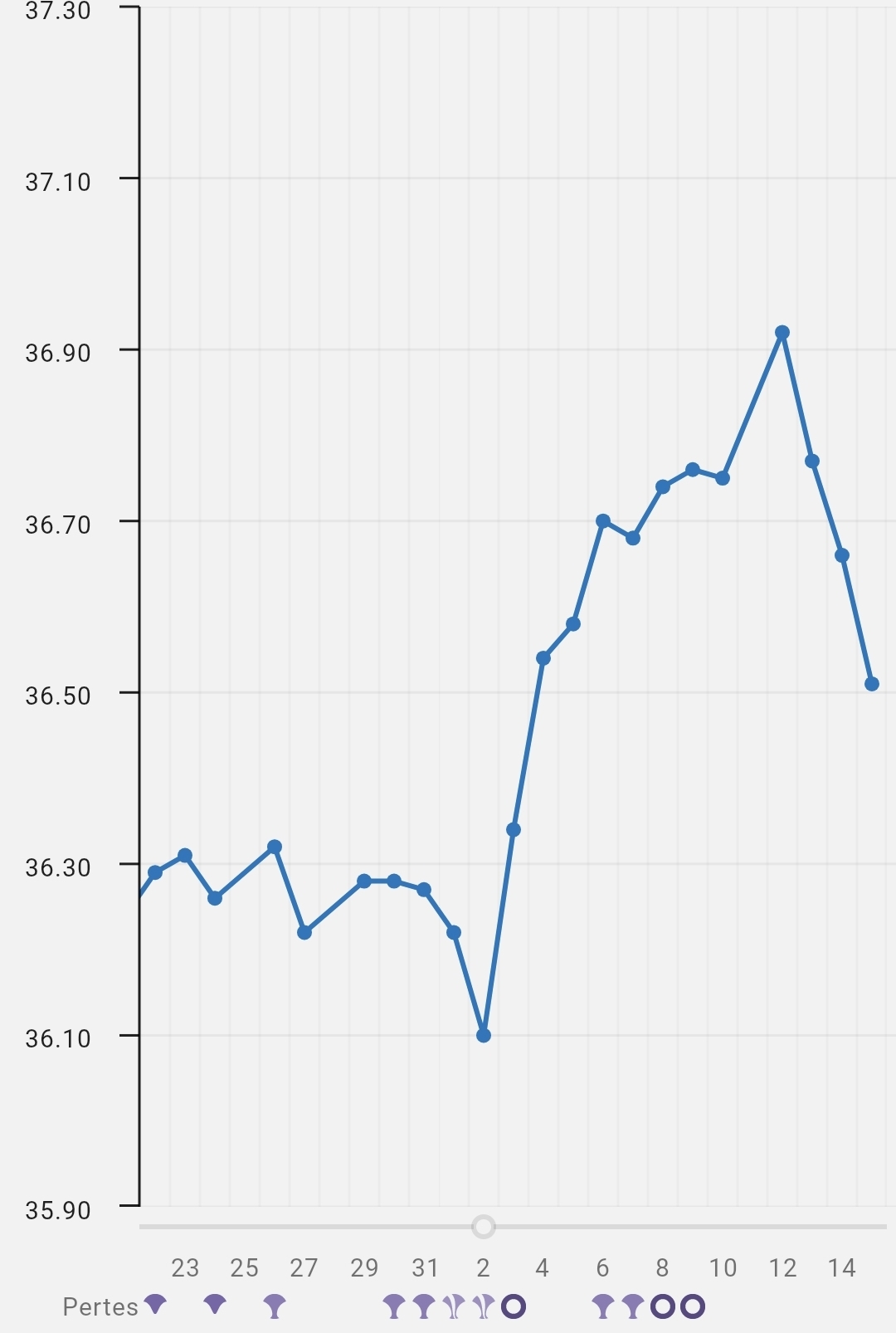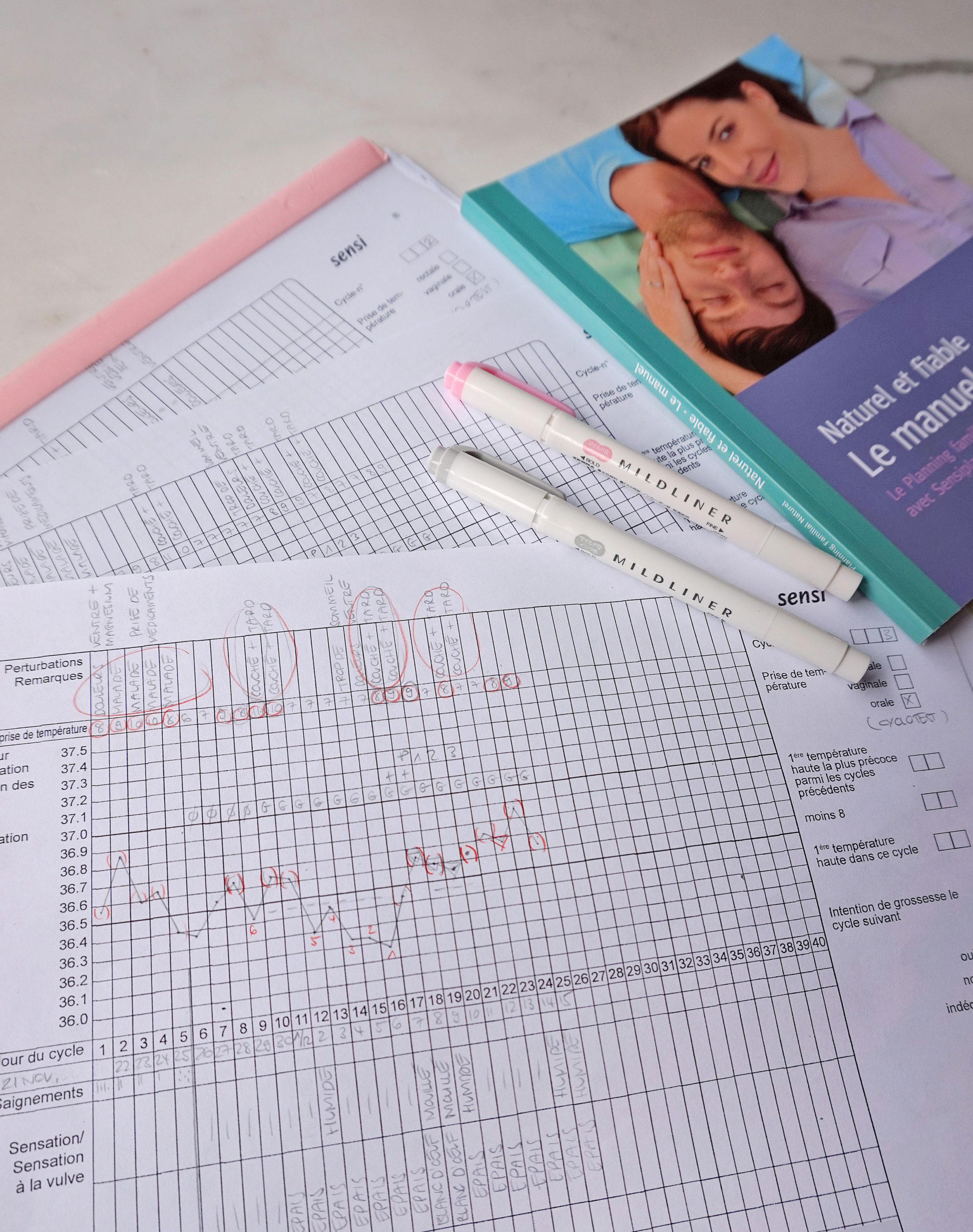A natural birth control as reliable as the pill? Yep, you read that right. In this article, I’m sharing all about the symptothermal method : how to use it, who is it for, the pros and cons – everything.
Heads up: some of the links in this article may be affiliate links. Click here to learn more.
If you’re here, chances are you’re in the same place I was a few years ago : you’ve stopped (or are thinking of stopping) hormonal birth control and you’re looking for a natural alternative.
Lucky you, I did the research, tested the symptothermal method so you don’t have to, and I’m sharing everything there’s to know.
Quick note: I’m not a medical professional or certified symptothermal educator. What I’m sharing here is based on my own research and personal experience with the method.
Symptothermal Method : How to Use it for Birth Control
The symptothermal method is all about tracking the changes your body goes through during your menstrual cycle.
It helps you detect ovulation and identify your fertile window so you know when you need to use protection to avoid pregnancy.
Throughout the roughly 28-day cycle, three physiological signs change in your body:
- Your basal body temperature (the lowest temperature when you’re at rest)
- Your cervical mucus (also called vaginal discharge)
- The position of your cervix
By observing these three things*, you can tell when you’re fertile (meaning there’s a chance of getting pregnant) and when you’re not fertile (meaning you can’t get pregnant).
I know many women don’t realize this, but you can only get pregnant during a small window of about 5 to 7 days in your cycle.
So even though hormonal contraceptives need to be taken or used every day of your cycle, they’re really only protecting you during that one week each month.
Meanwhile, men are fertile every single day of the year. Just saying.
*Actually, you don’t have to track all three signs. You could only track temperature + cervical mucus, or temperature + cervix position.
Personally, I track my temperature and mucus because it’s the simplest for me. I’ll mainly talk about this combo here, but just so you know, tracking your cervix along with your temperature is another option.
What Observations Are All About
Basically, it means taking your temperature every day at the same time — right when you wake up in the morning.
It’s important to use a basal thermometer so you can get readings with two decimal points.
When it comes to cervical mucus, you check every day what it looks and feels like at the vulva.
Because yep, our mucus changes throughout the cycle:
- Right after your period, it’s white and creamy.
- As ovulation approaches, it becomes clearer, more watery, and takes on an egg-white-like texture.
- After ovulation, it turns white again, thicker, and sometimes sticky.
Mucus helps sperm swim through the cervix during ovulation or blocks them once ovulation is over.
Honestly, I find it fascinating how our bodies naturally change to help us make babies—or not!
Once you have these observations, you note them down on a chart called a cyclogram.
What I do is first track my signs on a cycle app (I use Flo), then transfer everything onto paper.
Writing it down on paper is super important for getting a clearer picture and avoiding being influenced by app predictions, which aren’t always reliable.
Quick side note: all cycle tracking apps, including Natural Cycles, and smart thermometers like Daysy, rely on algorithms and predictions.
Even if you enter your temperature accurately, these tools base their data on past cycles and not on your current cycle (which is what the symptothermal method focuses on).
That’s why I always recommend writing down your observations by hand, especially when you’re starting out, so you can analyze your cycle as it unfolds.
Nothing replaces human analysis.
Analyzing the Data You Collect
I won’t go too deep into exactly what to look for and how, but to give you an idea, here’s what a typical temperature chart looks like (with a regular and healthy cycle).

At the start of your cycle (from day one of your period), your temperature will generally be pretty low.
Just before ovulation happens, your temperature may dip (like you can see on day 2 of this cycle). This dip signals that you’re about to hit your most fertile day.
Right after ovulation, if fertilization hasn’t occurred, your temperature will rise and stay elevated until your next period.
When you notice this temperature rise and it stays high for at least three days, that’s your first clue that ovulation has passed.
But that’s not all.
What makes the symptothermal method so reliable is that you get double confirmation by checking cervical mucus or cervix position.
After looking at your temperature, you check how your mucus has changed.
When your cervical mucus starts becoming clear, watery, and slippery, that’s your sign that ovulation and your fertile window are happening or about to happen.
Only once your mucus thickens up and turns cloudy or white do you get your second sign that your fertile window is over.
So it’s only when your mucus thickens AND your temperature rises and stays high that you can confirm ovulation has passed.
If your goal is to avoid pregnancy, you can have unprotected sex before and after your fertile window.
If you’re trying to conceive, this fertile window is when you want to get busy.
So no, the symptothermal method isn’t a birth control method that lets you have unprotected sex any time you want.
If you want to avoid pregnancy, you need to use protection or abstain during your fertile days.
Also, this method doesn’t protect against sexually transmitted infections, so please, before having unprotected sex, make sure your partner has been tested and is clean — this is super important.
Who Can Use the Symptothermal Method?
Any woman can use the symptothermal method to manage her fertility.
However, because it requires taking your temperature every morning at the same time, it’s better suited for women with a regular routine who sleep at least 4 hours straight (otherwise the data can get inaccurate).
And yes, women with irregular cycles can also use this method.
As we’ve seen, the symptothermal method isn’t based on predictions but on real-time observation of your body.
That means it doesn’t really matter when you think you’ll ovulate or get your period — you’ll find out for sure by paying attention to your body day by day.
Plus, tracking your cycle can help you understand why it’s irregular.
For example, noticing a short luteal phase might mean low progesterone. Or spotting a lack of ovulation could point to excess estrogen or androgens.
Only once you’re aware
Pros and Cons
Like everything in life, and just like any method out there, the symptothermal method has its ups and downs.
Pros
- No hormones involved. Your body doesn’t have to deal with side effects when you start or stop the method (hallelujah!). When I was on the pill, I didn’t realize how much it was messing with my body until I stopped — that’s when I saw the chaos it caused. And I thought, never again. Having a natural cycle is just amazing.
- 98% effectiveness recognized by the WHO (source). That’s as reliable as the pill, as long as you use the method properly.
- No recurring costs. You probably noticed I haven’t mentioned any expenses. The only thing you’ll need is a basal thermometer, which costs less than 20 EUR/USD/CHF (I use this one), and maybe a few sessions with a symptothermal educator to learn the method well. But that’s a one-time or short-term expense. That’s it.
- Learning about your body. Before I started, I had no idea why my cervical mucus texture changed throughout my cycle. Now, I realize everything happening in a woman’s body is tightly connected to the menstrual cycle. Honestly, we all should know how our bodies work.
- Seeing how your lifestyle affects your body
Cons
- Consistency is key. Taking your temperature and checking your cervical mucus are daily tasks, especially important when you’re just starting out with the method.
- There’s a learning curve. It’s not as simple as popping a pill every day at the same time and forgetting about it. It takes several months to really get the hang of tracking multiple cycles, understanding your body, and applying the method correctly.
Is it worth it? Absolutely. - You’ll need to protect or abstain during certain days. If you’re using the symptothermal method to avoid pregnancy, some sex acts will require protection or abstinence. But hey, no restrictions if you’re trying to conceive. And honestly, I see this as a positive — intimacy doesn’t always have to mean penetration; get creative ◡̈
- External factors can throw off your cycle tracking. Things like colds, medication, alcohol, lack of sleep, or heavy meals the night before can impact your data. But don’t worry, this doesn’t make the method ineffective or risky. The method accounts for these, and you’ll simply push your analysis back a day.
My Thoughts on the Symptothermal Method
As I update this article, it’s been 6 years since I started using the symptothermal method, and you’ve probably noticed by now that I’m a big fan and fully recommend it.
Since I stopped taking the pill, there’s been no turning back.
Living hormone-free has completely changed me, and I’ve reached a point of no return.
Even though the method might seem complicated or require effort at first, you’ll find that the more you get to know your cycle, the more freedom you gain.
That said, for the method to be effective, it’s essential to apply it correctly and consistently.
I can only recommend working with a qualified instructor to make sure you’re doing everything right and not taking any risks.
In my opinion, the symptothermal method is the best way to truly discover yourself and feel more woman than ever.

Ressources
If you want to learn more about this fertility awareness method, here a few ressources I can recommend, starting with books :
- Taking Charge of Your Fertility by Audrey Guillemaud
- The Complete Symptothermal Guide by R. Harri Wettstein
When it comes to thermometers, it’s important to choose a basal thermometer that shows two decimal places, like the iProven one.
There are also several apps that help you track your data and create charts. However, I don’t recommend relying solely on these apps.
Find out why they aren’t reliable as birth control methods on their own in this article.
I personally use the Flo app, but only to note my temperature, cervical mucus, and how I feel.
There are other apps like:
I really hope this piece of content helped you in your fertility awareness journey <3




